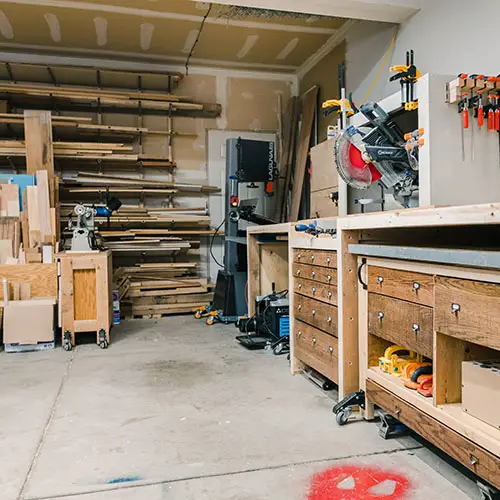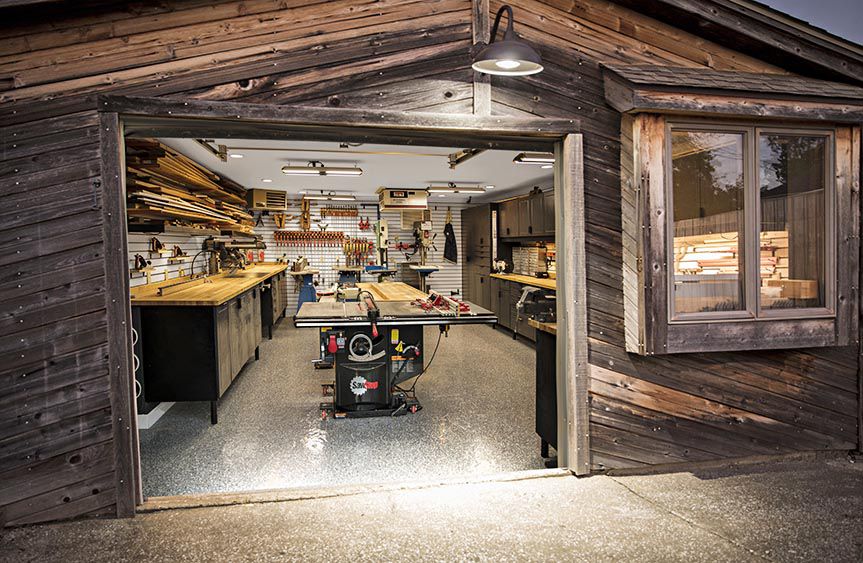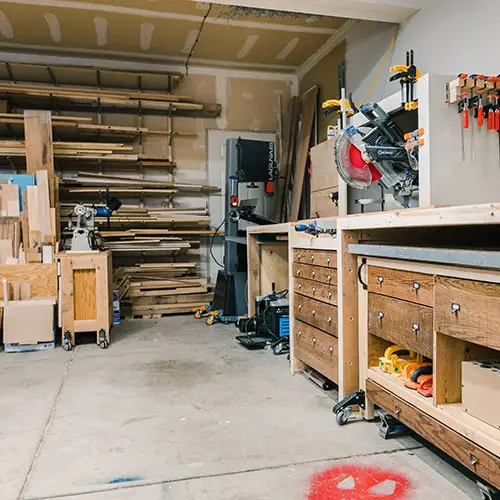Have you ever wondered if you can do woodworking in your garage? Well, I have some exciting news for you!
Woodworking is not only a fascinating hobby, but it can also be done right in the comfort of your own garage. Yes, you read that correctly!
In this article, we’ll explore the ins and outs of setting up a woodworking space in your garage and discover the endless possibilities that await you. So, let’s dive right in and get you started on your woodworking journey!
Yes, you can absolutely do woodworking in your garage! With the right tools and setup, your garage can become a functional and enjoyable woodworking space. Start by organizing your tools and creating a dedicated work area. Invest in a sturdy workbench, proper ventilation, and good lighting. Consider installing dust collection systems to keep your garage clean. Lastly, make sure to follow safety guidelines and wear protective gear. Happy woodworking!

Can I Do Woodworking in My Garage?
Woodworking is a popular and rewarding hobby that allows individuals to create beautiful and functional pieces of furniture and decor. For many woodworking enthusiasts, the garage is a common workspace due to its ample space and versatility. But before you dive into your woodworking projects, it’s important to consider if your garage is a suitable environment for woodworking. In this article, we will explore the factors to consider, the tools and equipment required, and the steps you can take to create a safe and effective woodworking space in your garage.
Setting Up Your Garage for Woodworking
1. Space and Layout
When setting up a woodworking space in your garage, the first thing to consider is space. Take measurements of your garage to determine how much room you have to work with. Ensure that you have enough space for your workbench, tools, and materials, as well as adequate ventilation and lighting. It’s also important to plan your layout in a way that allows for efficient workflow and easy access to your tools and materials.
2. Power Supply and Electrical Safety
Woodworking requires the use of power tools, which means you will need a reliable power supply in your garage. Ensure that your garage has enough electrical outlets to accommodate your tools and equipment. It’s also crucial to follow electrical safety guidelines, such as using grounded outlets, avoiding extension cords whenever possible, and having circuit breakers or fuses to prevent overloading.
3. Ventilation and Dust Collection
Woodworking can create a lot of dust and fumes, which can be hazardous to your health if not properly managed. Make sure your garage has adequate ventilation to remove dust and fumes from the air. Consider investing in a dust collection system or using portable dust extractors to minimize airborne particles. Additionally, wear personal protective equipment, such as a dust mask or respirator, to protect yourself from inhaling harmful particles.
Essential Tools and Equipment for Woodworking
1. Workbench
A sturdy and well-built workbench is the foundation of any woodworking space. It should be large enough to accommodate your projects and have a flat and stable surface for precise work. Consider building or purchasing a workbench with integrated storage options to keep your tools and materials organized.
2. Hand Tools
Hand tools are essential for woodworking projects, regardless of whether you have access to power tools. Some basic hand tools you’ll need include chisels, a mallet, planes, a coping saw, clamps, and measuring tools like a tape measure and combination square.
3. Power Tools
Power tools can greatly speed up your woodworking projects and allow you to tackle more complex tasks. Some essential power tools include a table saw, miter saw, drill press, router, and orbital sander. Invest in high-quality tools that are suitable for your projects and always follow safety guidelines and instructions.
Safety Measures and Tips for Woodworking in Your Garage
1. Organize and Maintain a Clean Workspace
Keeping your workspace clean and organized is crucial for safety in woodworking. Clear clutter, remove sawdust and debris regularly, and safely store your tools when not in use. This not only reduces the risk of accidents but also ensures that your tools and equipment stay in good condition.
2. Wear Personal Protective Equipment
Woodworking involves sharp tools and the production of flying debris. Always wear safety glasses or goggles to protect your eyes, and use hearing protection when operating loud machinery. Additionally, wear fitted clothing to avoid loose fabric getting caught in machinery, and consider wearing gloves to protect your hands.
3. Learn and Follow Safety Guidelines
Before starting any woodworking project, familiarize yourself with safety guidelines and best practices. Take the time to learn proper tool usage, cutting techniques, and safe workholding methods. Always pay attention to your surroundings and never rush through a project.
Creating a Safe and Efficient Woodworking Space
Once you’ve decided to embark on woodworking projects in your garage, it’s important to ensure that your space is both safe and efficient. Here are three additional considerations to make before getting started.
Optimizing Workflow and Organization
A well-organized and efficient woodworking space allows for seamless project execution and reduces the chances of accidents or mistakes. Consider implementing the following strategies to optimize your workflow and organization:
1. Designate Work Zones: Create designated areas for specific tasks, such as cutting, assembly, and finishing. This will help streamline your workflow and minimize unnecessary movement.
2. Utilize Vertical Space: Install shelves or wall-mounted storage systems to maximize storage space for tools, materials, and safety equipment. This will free up valuable floor space and keep your garage tidy.
3. Implement a Tool Organization System: Use tool racks, pegboards, or tool chests to keep your tools organized and easily accessible. This not only saves time but also prevents tools from getting damaged or lost.
Ensuring Proper Lighting and Ventilation
Good lighting and ventilation are essential for a safe and comfortable woodworking environment. Consider the following tips to ensure proper lighting and ventilation in your garage:
1. Natural Lighting: Maximize natural light by installing windows or skylights in your garage. This not only provides better visibility but also helps in accurately assessing the colors and finishes of your woodworking projects.
2. Artificial Lighting: Supplement natural lighting with well-placed artificial lights. Consider installing task lighting above your workbench and additional overhead lighting to illuminate the entire space.
3. Ventilation: Ensure your garage has adequate ventilation to remove dust, fumes, and stagnant air. If natural ventilation is insufficient, consider installing exhaust fans or air purifiers to maintain good air quality.
Conclusion
Woodworking in your garage is a feasible and rewarding endeavor with the right planning and preparation. By optimizing your workspace, investing in the necessary tools and equipment, and prioritizing safety measures, you can create a space where you can indulge in your woodworking passion. Remember to stay organized, follow safety guidelines, and continuously improve your skills and knowledge. With time and practice, you can confidently take on new woodworking projects and create beautiful pieces right in your garage. Happy woodworking!
Can I Do Woodworking in My Garage?
- 1. Yes, you can do woodworking in your garage if you have enough space and proper ventilation.
- 2. Make sure to organize your tools and materials efficiently to maximize workspace.
- 3. Consider investing in a workbench or a sturdy table to work on.
- 4. Use appropriate safety measures, such as wearing safety glasses and using dust collection systems.
- 5. Remember to check local regulations regarding noise and waste management.
Frequently Asked Questions
Welcome to our list of frequently asked questions about woodworking in your garage. Whether you’re a beginner or an experienced woodworker, we’ve got answers to common questions that can help you get started or improve your skills. Read on to find out more!
1. How much space do I need for woodworking in my garage?
While the amount of space you need depends on the specific projects you plan to undertake, a general rule of thumb is to have at least a 2-car garage. This will give you enough room for your woodworking bench, tools, and materials, as well as some space to move around comfortably. Consider organizing your garage efficiently to maximize the available space.
If you have a smaller garage, don’t worry. You can still do woodworking, but you may need to get creative with your setup. Look for space-saving storage solutions, such as wall-mounted tool racks and foldable workbenches. With thoughtful planning, you can make the most of the space you have.
2. What tools do I need to get started with woodworking in my garage?
When starting out, it’s essential to have a few basic tools that will allow you to complete a variety of woodworking projects. Some must-have tools include a circular saw, a power drill, a chisel set, a tape measure, a hand plane, and a set of screwdrivers. These tools will cover the basics and allow you to tackle many beginner-level projects.
As you progress and gain more experience, you can expand your tool collection to include specialized tools for specific woodworking techniques or projects. Consider investing in tools like a miter saw, a router, and a table saw. However, remember that it’s not always about the number of tools you have, but rather how well you understand and use them.
3. How do I ensure good ventilation in my garage for woodworking?
Good ventilation is crucial when doing woodworking in your garage, as it helps to remove dust, fumes, and airborne particles that can be harmful to your health. One way to improve ventilation is by opening windows and using fans to create a cross breeze. This helps in circulating fresh air and removing dust particles from the workspace.
Another effective solution is to install an exhaust fan or a dust collection system. These systems can help to capture and filter airborne particles, ensuring that the air in your garage remains clean and safe to breathe. Regularly cleaning your workspace and using dust collection attachments on your power tools can also help in minimizing dust in the air.
4. How can I make my garage more soundproof for woodworking?
Woodworking can produce loud noises, especially when using power tools like table saws or routers. If you live in a neighborhood with noise restrictions or simply want to reduce noise pollution, there are several steps you can take to make your garage more soundproof. One option is to install sound-dampening panels on the walls or ceiling of your garage.
You can also add weatherstripping to the garage door to help seal any gaps and reduce noise leakage. Adding rugs or rubber mats to the floor can help absorb sound vibrations as well. Additionally, consider using quieter hand tools whenever possible, and use noise-reducing earmuffs or earplugs to protect your hearing while working.
5. Are there any safety precautions I should take when doing woodworking in my garage?
Woodworking can be a rewarding hobby, but it’s essential to prioritize safety to prevent accidents and injuries. Always wear appropriate safety gear such as safety goggles, ear protection, and a dust mask. Familiarize yourself with the proper use of each tool and follow all safety guidelines provided by the manufacturer.
Additionally, make sure your workspace is well-lit and free from clutter. Keep your tools properly maintained and sharp to avoid mishaps. It’s also a good idea to have a fire extinguisher nearby and know how to use it. Finally, always work at a pace that is comfortable for you, and never rush through a project, as this can lead to mistakes or accidents.

Can Your Workbench Do This?
Summary:
Woodworking can be done in a garage, but safety precautions and space organization are important. Make sure you have proper ventilation and wear protective gear. Use appropriate tools and organize your workspace efficiently to avoid accidents and maximize productivity.
In conclusion, woodworking in your garage is possible with the right setup and safety measures. Just remember to prioritize safety, get the necessary equipment, and keep your workspace organized for an enjoyable and fulfilling woodworking experience.
